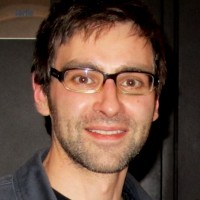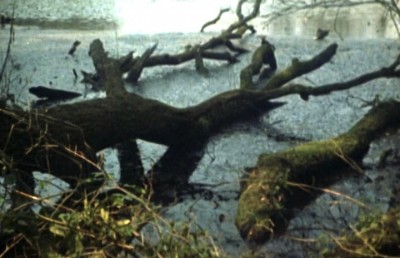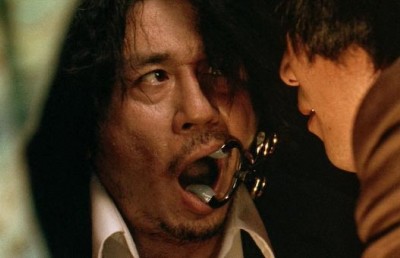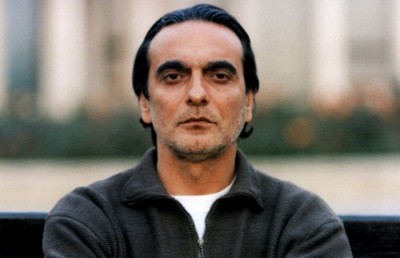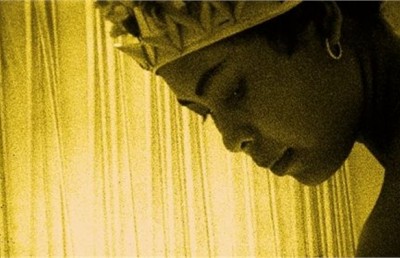Peter Greenaway Conference Notes
Cinema Speak
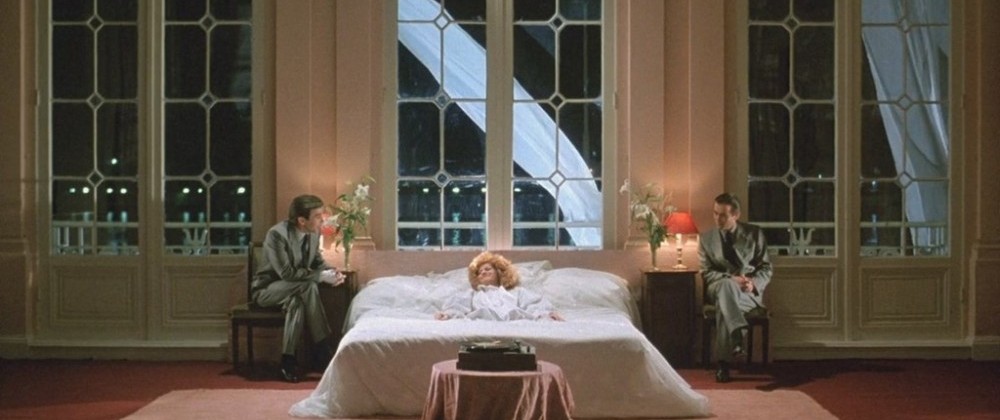
Rochester New York, April, 1997
Attended by Nicholas Renaud and Daniel Lynds
Transcribed by Daniel Lynds
A CINEMA EPITAPH
“We must not forget what Derrida suggested that the image always has the last word.”
It is on this premise that we present this text. In transcribing Greenaway’s “lecture” several deletions were made in order to make it more concise. I would also like to state that I didn’t add any words in fear of influencing readers. The audience’s questions have been deleted because Greenaway’s answers incorporated them. In any case this lecture presents us with all of the concerns that have informed Greenaway’s career as well as new ideas about film, religion, and technology.
ON PAINTERS AND WRITERS AND WRITERS AND PAINTERS
I really don’t think we’ve seen any cinema yet. 1895. 1995. A hundred years of what I consider to be a prologue to cinema. Whether your name is Scorsese or Spielberg or Wenders or Godard or Tarantino. The movie business we have created so far has to start with text. We have to have the notion of text before we can have image. I really don’t think that cinema is an adjunct to the bookshelf. You have probably heard of a film that has received a lot of attention recently called THE ENGLISH PATIENT. Why would anybody bother to make an illustrated version of the book? Why do we feel so culturally inferior with cinema that it is not able to make it’s own products? Why must it recreate literature which already exists in it’s own viable form? I believe that we have no intrinsic cinematic cinema but rely on textual motifs which originate in the Nineteenth century. I would continually look for ways in which to combine models or metaphors to see if we could reinvent some type of cinema. I don’t think we have seen any really interesting cinema in thirty years. The investigative radical cinema probably disappeared in the seventies with the Germans. With people like Fassbinder, Herzog, and now even Wenders. My interest in this film THE PILLOW BOOK is to look for a proposition whereby image and text work together most successfully. Where I come from in an English culture, writers are supposed to be writers and painters are supposed to be painters. The two worlds are not supposed to mix. This type of fortress mentality is most unfortunate if you really want to create a new type of cinema.
THE ACCELERATION OF VOCABULARY
My great American hero John Cage said if you introduce more than twenty percent of novelty into any new artwork, watch out you’ll lose eighty percent of your audience. I would not wish, in any manner of means, to lose contact with an audience. However much I would want to push forward the vocabulary. Every novelty immediately creates it’s own predecessor and certainly a great French film director, Abel Gance, was using multiple screens for his NAPOLEON of the nineteen twenties. I think that he was able to exceed the possibilities of the medium. He almost had to recreate the architecture of cinema. The use of split screens have mostly been decorative. Most of this experience has been upgraded with the burst of new technologies. There is a way that we can do the split screens quite easily and quite unexpectedly. So we can`t begin to use this enormous potential, which I`ve always believed was quite similar to the human experience. Although we walk along the street in the present tense we must realise that nothing makes any sense without memory. We should walk along the street relating our present tense to our imagination, to our memory and to our fantasy. In using the split screen I can play with all sorts of devices. I can show you the past, present, and future all in one frame. I can show you a wide shot, a close up, and a medium shot all in one frame. There is a lot of talk nowadays about interactivity. Well I`m not really sure what interactivity really is and I`m sure you don`t either. The most interactive event I can think of is reading a book. But in offering you a series of screens to look at you have a choice. You could look at one screen and then another. I hope to make a cinema that is infinitely beautiful so that upon a second viewing you might choose different screens which would allow you to experience the film from another experience.
ALEXANDER NEVSKY AND MICHAEL NYMAN
Michael Nyman and I have made approximately thirty films together and not just the feature work but the television work. When we started many, many years ago we based the idea of our collaboration on the relationship between Prokofiev and Eisenstein when they made ALEXANDER NEVSKY. Both of the gentlemen discussed the film before a frame was turned in the camera. In the end we [Greenaway & Nyman] began to exhaust one another. So I believe that the relationship with Michael Nyman is closed and shall remain that way. This allows Michael to work with several other film directors while I can be eclectic and work with many composers on one soundtrack. I want people to hear the music in my films independent of what`s going on in the film. That sense of artificiality is part of the vocabulary I have developed over the years to point out that you are only watching a film.
CINEMA.LINGUISTIC.COM
Cinema is in desperate straits and has been for thirty years. We should really want to make it into a radical sophisticated art form that contains all of the excitement of all the other art forms and willing to really move forward for the rest of the millennium. I don`t think cinema should be a narrative medium. Cinema is capable of other wonderful things. For example, twentieth century music which has lost melody in order to get onto some really interesting questions about musicality. Looking at painting here in America which lost it`s notions of figuration in order to get on to something which painting can do so much better. Maybe it`s time now to give up what Griffith invented for the cinema, the notions of narration, the notions of storytelling, in order to let filmmaking get on with what it could really do extremely well. Underground and experimental film could be profitably examined and looked at in order to take cinema into an extraordinary position at the beginning of the twenty first century.
ROMAN CATHOLICS AND CD-ROMS
I also feel that the tyranny of having to tell stories in cinema has almost been as heinous as the introduction of virgin birth into Roman Catholicism. It was absolutely not necessary and now we are suffering for it. To be a good Roman Catholic you have to believe in the suspension of disbelief about virgin birth. And suspension of disbelief, of course, is an absolute essential in cinema. So Roman Catholicism and cinema work on the same premise. I think there are all sorts of new technology that will help us with this. The ideas of changing the notions of the time frame are adhering. So the possibilities of interactivity, the possibilities of the Internet and the CD-ROM throw the time frame of the seconds of visual imagery onto your hands and away from me. There is a way in which you watch a film, any film, where you accept the fact that the director’s subjectivity was creating images that he wanted you to watch. I think the terms in which our political democracy and notions of being able to field and organise the whole business of this huge information age we are about to approach, should give you the viewer far more control over the circumstances of the notion of the seventh art, cinema. And I’m sure whether I like it or not, or whether you resist it or not, it is eventually going to happen.
THE PILLOW BOOK
1.BLACK AND WHITE
The two main ideas that interested me were: 1) that we acknowledge our physicality, corporeality, and our sexuality. 2) The notion that we can put our thoughts down into literature. It is a celebration of all the ways in which sex and text can come together. But I suppose, over and above that, the whole film is about layers of communication. We have here a film which is very much organised in terms of very contemporary television language. Notions of the fragmented screen. Utilisations of black and white, and colour. Ideas of utilising various forms of monocolour. Fragmentation of the frame which are familiar, I suppose, from television programs. Certainly the acceptance of other art forms in terms of, for example, the cartoon and comic. Text is used in terms of the organisation of the picture frame. I would like to think also that there are a series of quotations which are very much about notions in which films are made.
2.BABEL AND CADENCES
The film for me is very much like a proposition of a tower of Babel. I think there are something like 26 languages in the film. And my ideal audience, which I suspect is absolutely impossible, would need to speak tenth-century Japanese, contemporary Japanese, Cantonese, Mandarin, a little Vietnamese, some South Korean, some North Korean, some Pilipino. And going back through Europe certainly some French and English. One or two words of Yiddish and some Sanskrit. And certainly some Ancient Egyptian. And, uh, several other languages as well. And I know the chances of that happening are very, very slim indeed. But as I would suggest it is meant to be, in some senses an essay or dissertation about communication through language, both oral and written. But either way I’m sure that you realized and made it a subject of your frustrations. But a lot of the Japanese was deliberately not translated. In order to get you to listen to the cadences, and the rhythms, and the music of a language which is not your own. I would like to think that my reversions of not translating the Japanese, in the end was not antagonistic to your ideals of comprehension. But inevitably if you had been patient and waited a little longer, you could understand in fact what had been said.
3.EAST MEETS WEST
What I wanted to do was to use the sensibilities of an eastern appreciation of the world and see if we could find co-adjoining associations so that we could make the west-east access. I hoped this could work on several different levels. If I could just list one or two of them. There is no such thing as a frame in the Orient. The frame is an obsession we have in the occident. Our knowledge of painting differs greatly from that in the east. The west seeks to hide the background while the east seeks to reveal the background. This underlines the difference between the visual languages of the east and west.
4.NECROPHILIA AND OVERDOSING
So there are many, I suppose, strategies. You’ll notice for example that when Jerome is popping pills on his way to an early grave that the walls behind his bed was giving you a huge transcript of all the forgotten languages in the world. Gradually working all the way backward until the moment of his death when you see the most necrophilic of all languages, which was Egyptian of the First Dynasty. Which allowed layers of meaning very much associated with the notion of language which is playing all sorts of games all the time. If I was interested in the very business of writing on flesh I would have made myself a list of all the ways, in fact, which flesh could be written on.
5).MIZOGUCHI AND OZU
For example there are three different film styles in the film. There’s the one which is basically rooted in Japanese Classic Ozu cinema, Mizoguchi. Whereby you have a black and white picture which is basically cinemascope. Where very little happens in terms of physical activity for more of a great sense of suppressed emotional activity. The second area of filmmaking is related to ideas of poetry and unexplainable events. The third area is related to ideas of the post-cinema-verité/ post-Nouvelle Vague/ ER/ NYPD BLUE hand-held camera.

